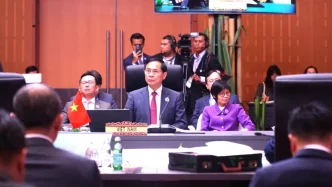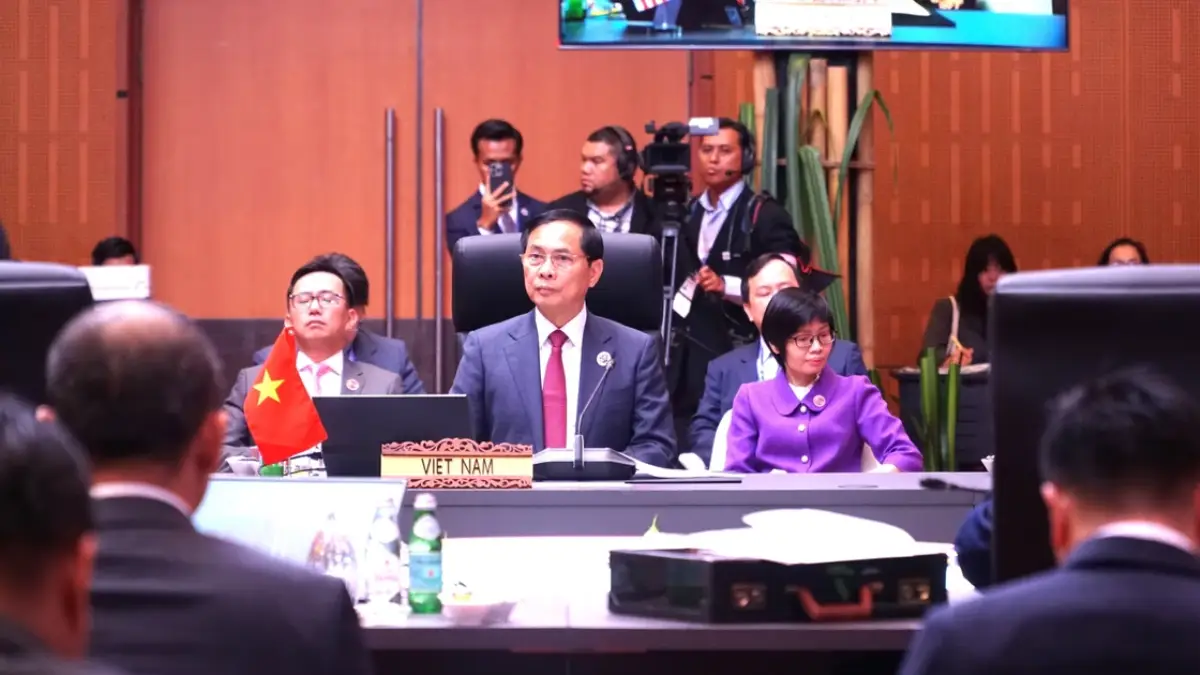At the 58th ASEAN Foreign Ministers’ Meeting in Kuala Lumpur on July 9, 2025, Vietnam’s Deputy Prime Minister and Minister of Foreign Affairs Bùi Thanh Sơn laid out an ambitious vision for the Association of Southeast Asian Nations (ASEAN). Amid a backdrop of global volatility and regional uncertainties, Sơn proposed three strategic priorities to reinforce ASEAN’s central role: driving economic growth to position the bloc as the world’s fourth-largest economy by 2030, building a leading digital community, and deepening people-to-people connectivity for a more inclusive regional framework.
Navigating Uncertainty with Economic Ambition
The plenary session of the ASEAN Foreign Ministers’ Meeting, held at the Convention Centre in Kuala Lumpur, served as a critical platform for implementing decisions from the 46th ASEAN Summit and charting the future of ASEAN Community-building efforts. Ministers collectively underscored the importance of sustaining ASEAN’s role as a hub for cooperation, dialogue, and strategic trust. The urgency to accelerate the ASEAN Community Vision 2045—a long-term blueprint for regional integration—was a recurring theme, with calls for sectoral bodies to translate high-level directives into actionable outcomes.
Sơn’s first priority focused on economic growth as a cornerstone of ASEAN’s future. He advocated for robust intra-regional economic integration, emphasizing the need to effectively implement the upgraded ASEAN Trade in Goods Agreement (ATIGA). This, he argued, would strengthen trade within the bloc while leveraging existing Free Trade Agreements (FTAs) with external partners. Additionally, Sơn highlighted the potential of the Regional Comprehensive Economic Partnership (RCEP), one of the world’s largest trade pacts, to expand inter-regional linkages. He also pointed to e-commerce as a vital tool for unlocking internal trade potential and accessing new markets and supply chains, positioning ASEAN to capitalize on global economic shifts.
The goal is clear: to transform ASEAN into the world’s fourth-largest economy by 2030. This ambitious target reflects not only economic aspirations but also a strategic response to geopolitical tensions and economic weaponization, issues raised during the meeting. Sơn’s emphasis on diversifying external partnerships and enhancing intra-regional trade and investment aligns with broader discussions among ministers, who stressed the importance of infrastructure connectivity, energy grids, and digital networks to bolster economic resilience.
Digital Transformation as a Growth Engine
Beyond traditional economic strategies, Sơn urged ASEAN to position itself as a leader in the digital economy. His second priority called for accelerated negotiations on a Digital Economy Framework Agreement tailored to real-world needs, particularly for micro, small, and medium-sized enterprises (MSMEs), which form the backbone of many ASEAN economies. Embedding digital transformation and innovation ecosystems into cooperation frameworks with external partners, he suggested, could attract vital resources and technical support.
As Chair of the ASEAN Initiative for ASEAN Integration (IAI) Task Force, Vietnam is poised to play a pivotal role in these efforts. Sơn committed to coordinating the implementation of digital initiatives under the next IAI Work Plan, ensuring that subregional cooperation reflects these priorities. This focus on digitalization also ties into broader ministerial discussions on emerging growth drivers, with ASEAN leaders recognizing the need to adapt to technological advancements and global trends to remain competitive.
The push for a digital community is not merely about economic gains; it is also a response to the region’s pressing challenges. Ministers at the meeting highlighted the importance of resilience against climate change, natural disasters, and extreme weather events—issues that digital tools and innovation can help address through smarter infrastructure and disaster response systems. Sơn’s vision, therefore, integrates economic and environmental sustainability, reflecting ASEAN’s broader commitment to inclusive development.
Bringing ASEAN Closer to Its People
Sơn’s third strategic direction emphasized the human dimension of ASEAN’s mission. He argued that beyond high-level declarations, the bloc’s presence must be felt through tangible, meaningful actions. Enhancing the region’s communication strategy to promote ASEAN’s achievements through real stories of individuals and communities was a key proposal. Vietnam, he noted, will soon develop a national implementation plan for ASEAN’s strategic 2045 documents to bring the organization closer to its citizens, businesses, and local communities.
This focus on people-to-people connectivity resonated with the plenary’s broader themes. Ministers stressed the need for initiatives that directly benefit citizens, such as improved connectivity, food security, education, healthcare, and climate resilience. Sơn’s call for deeper engagement reflects a recognition that ASEAN’s success depends not only on governmental cooperation but also on public support and awareness of the bloc’s contributions to regional stability and prosperity.
Unity and Centrality in a Volatile World
Throughout his address, Sơn reaffirmed the core values underpinning ASEAN’s success: unity, mutual respect, and a commitment to inclusive, sustainable development. In a world marked by volatility, he emphasized that ASEAN’s centrality must remain a guiding principle. This sentiment was echoed by Malaysian Prime Minister Anwar Ibrahim, who, in his opening address to the meeting, urged ASEAN to remain proactive, strategically autonomous, and united in shaping the region’s future.
Anwar warned against the weaponization of economic tools for geopolitical competition, a concern shared by many in the region as global powers vie for influence in Southeast Asia. He called for ASEAN to determine its own path with purpose and vision, promoting meaningful integration and stronger coordination across diplomatic and economic pillars. His vision of an inclusive, sustainable economy aligned closely with Sơn’s proposals, particularly in areas like connectivity and digital transformation.
Support for Timor-Leste’s Integration
A notable highlight of Sơn’s address was Vietnam’s reaffirmed support for Timor-Leste’s accession to ASEAN. He expressed readiness to assist the country in meeting membership criteria, including participation in legal instruments, and called for a clear roadmap to ensure Timor-Leste’s effective integration. This stance was supported by Anwar, who expressed hope to welcome Timor-Leste as ASEAN’s next official member, emphasizing the importance of institutional and visionary integration into the regional framework.
Timor-Leste’s potential membership represents both an opportunity and a challenge for ASEAN. Expanding the bloc could strengthen its regional influence, but it also requires careful coordination to ensure new members align with ASEAN’s goals and operational frameworks. Vietnam’s proactive role in this process underscores its growing leadership within the organization.
Strategic Autonomy Amid Global Challenges
The Kuala Lumpur meeting unfolded against a backdrop of mounting global volatility, with ministers repeatedly emphasizing the need for ASEAN to maintain strategic autonomy. This concept, central to the bloc’s identity, involves balancing relationships with major powers while prioritizing regional interests. Sơn’s proposals, with their focus on economic and digital advancement, offer a pathway for ASEAN to assert its independence by building internal strength and resilience.
The discussions also reflected broader concerns about external pressures, including trade disruptions and geopolitical rivalries. By prioritizing intra-regional trade, diversifying partnerships, and investing in digital infrastructure, ASEAN aims to reduce its vulnerability to external shocks. Sơn’s vision aligns with this strategy, positioning economic growth and innovation as tools for both development and autonomy.
Looking Ahead: Challenges and Opportunities
As ASEAN moves forward with its Community Vision 2045, the priorities outlined by Sơn and supported by other ministers provide a roadmap for navigating an uncertain future. Economic integration, digital transformation, and people-centric engagement are not just goals but necessities in a region facing complex challenges, from climate change to geopolitical tensions.
Vietnam’s leadership, particularly in coordinating digital initiatives and supporting Timor-Leste’s integration, signals its commitment to shaping ASEAN’s trajectory. Yet, the path ahead is fraught with obstacles. Translating high-level strategies into concrete actions will require sustained cooperation across member states and sectors, as well as innovative approaches to funding and implementation.
As the outcomes of the 58th ASEAN Foreign Ministers’ Meeting are implemented, the region’s ability to balance economic ambition with strategic autonomy will be tested. For now, Vietnam’s proposals offer a compelling vision for a stronger, more connected ASEAN—one that prioritizes both its people and its place on the global stage.















